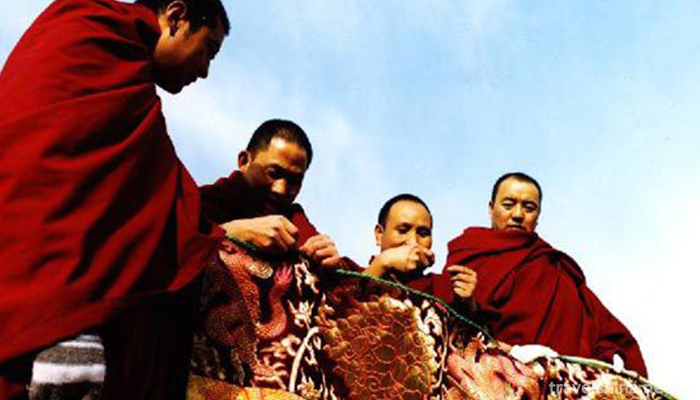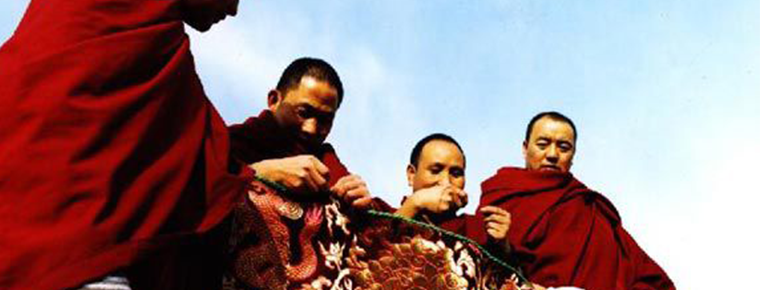Huangzhong embroidery
Huangzhong embroidery
Huangzhong heap embroidery is a kind of art that uses the techniques of "shearing" and "heap" to create images. It is mostly used in Tangka production, with Tibetan Buddhist themes as its main content. The piling embroidery in Huangzhong County has a history of more than 600 years. The piling embroidery in the Tar Temple in Huangzhong County is a treasure of Tibetan Buddhist art. It is known as one of the three greatest Arts in the Tar Temple and is well known.
On June 7, 2008, Huangzhong Pile Embroidery was approved by the State Council to be included in the second batch of national intangible cultural heritage list.
Brief introduction of embroidery
Huangzhong heap embroidery has a history of more than 600 years. It is created and inherited by the Han and Tibetan people in Huangzhong County. It combines national culture and folk art into a furnace and has great value. It combines relief and embroidery skillfully, and has high value of Arts and crafts and aesthetic value.
This is the county's tall temple butter flowers, Canadian Tibetan carpet weaving skills, Huangzhong peasant paintings, 1000-family camp platforms, but West Dewa village after the ancient game, the county's cultural skills were once again included in the provincial cultural heritage list. So far, the county has been included in the provincial intangible cultural heritage list of seven projects, including Tar Temple butter flowers and Jiaya Tibetan carpet weaving skills were also included in the national intangible cultural heritage list.
Origin of embroidery
Tangka heap embroidery has strong nationality and religion. Will it make the market of heap embroidery broader if it is used as the craftsmanship of Tangka heap embroidery to make crafts with rich life flavor? Therefore, she tried to use the composition and color matching techniques of traditional Chinese painting to enrich the themes of heap embroidery. A series of heap embroidery crafts developed soon attracted a large number of customers.
Traditional Tangka heap embroidery is different, heap embroidery handicraft is cut into various patterns and shapes by various colors of cotton, silk and satin, carefully stacked and pasted into a complete picture. The process includes pattern design, cutting, stacking and coloring of individual patterns. Generally speaking, the main part of pattern design is customer demand. Sketching is the most important step to consider the artist's painting skills. After the pattern design is completed, all kinds of cloth are cut and glued better than the pattern, and then filled with wool or cotton to make the pattern protrude. Finally, all kinds of cloth patterns are stacked on the designed large-scale cloth mantle to form a complete set of pictures, so as to achieve a static, vivid and lifelike situation. Make the picture rich and vivid three-dimensional sense and fabric unique texture sense, achieve the artistic effect of shallow relief, rich expression. The works are exquisite in roughness, wonderful in every drop, exquisite in skill and ingenuity. A pile of embroidery can be said to be a silk color relief work, which has great artistic and ornamental value.
Inheritance of embroidery
Since 2008, under the arrangement of Sunshine Office and Poverty Alleviation Office in Huangzhong County, the Tibetan Culture and Art Vocational School in Huangzhong County has successively held piling embroidery training classes for rural women in Zhenyi and Geercun villages in the western part of Huangzhong County, Gonghe Town, Xizhuang Village and Nancun villages, etc. The vocational and technical school in Huangzhong County of Qinghai Province has offered arts and crafts classes, inviting art monks from Buddhist monasteries to come to school classes for local farmers. The children taught Tangka and embroidery production techniques, which were welcomed by local farmers. Farmer women's embroidery works were purchased by Shengyu Cultural Communication Co., Ltd., a subsidiary of Huangzhong Tibetan Culture and Art Vocational School. More than 200 rural women in the county have been trained in embroidery technology.


-
1.Yashan Huahai Stone Forest
Yashan Huahai Stone Forest Tourist Area, located in Nanling County, Wuhu City, Anhui Province, is one of the important scenic spots in Anhui's "two mountains and one lake" tourism economic c
Time 2018-12-20 -
2.Wuyuezhai Scenic Area
Wuyuezhai Scenic Area, National Forest Park, AAAAAA Tourist Area, is located in the eastern foot of Taihang Mountain, located in the northwest of Lingshou County, Hebei Province
Time 2018-12-22 -
3.Qinhu National Wetland Park
Qinhu National Wetland Park is located between the central part of Jiangsu Province and the Yangtze and Huaihe River. The total area of the scenic spot is 26 square kilometers.
Time 2019-02-07 -
4.Avanti
Avanti, also translated by the Albanian side, (Uygur "Mr." means, Arabic: Juha or Nazar Ding), is a person active in Islamic nationalities from Morocco in the west to Xinjiang in China.
Time 2019-03-28 -
5.The Dragon Boat Festival
Dragon Boat Festival, also known as Dragon Boat Festival, Double Boat Festival, Midday Festival, Dragon Boat Festival, Zhengyang Festival, Bath Orchid Festival, Tianzhong Festival,
Time 2019-04-28 -
6.Forty eight Zhai Song Festival
The forty-eighth Village Song Festival is a northern Dong dialect Song Festival in Tianzhu County, Guizhou Province, China. It is a traditional national festival featuring Dong
Time 2019-05-01 -
7.Huanglong drama
Huanglong Opera, a local traditional drama in Nong'an County, Jilin Province, is one of the national intangible cultural heritage.
Time 2019-05-04 -
8.Jiashan Tian Ge
Jiashan Tiange is a local folk song in Zhejiang Province. It belongs to a variety of Wuge songs. It is a unique form of ballad in Zhejiang Province. It is a song that workers sought comfort and expres
Time 2019-05-05 -
9.Quwoqin Books
Quwo Qinshu is a kind of local traditional folk art form which was formed and mainly popular in Quwo County in the south of Shanxi Province and its adjacent areas of Shanxi, Shanxi and Henan provinces
Time 2019-06-11 -
10.Uygur Residential Architecture Skills Aiwan Sailai Residential Construction Skills
Uygur Aiwan Sailai dwellings are mainly distributed in towns and villages along the desert edge of the Tarim Basin, especially in Yutian, Moyu, Minfeng, Pishan, Hetian, Shache and Kashgar along the so
Time 2019-06-26 -
11.Fan making Techniques
Suzhou Fan is a special product of Suzhou. It is famous for its elegance, delicacy and artistic characteristics. Including folding fan, sandalwood fan and silk Palace fan, collectively known as "
Time 2019-07-25 -
12.Traditional preparation methods of traditional Chinese medicine
Traditional Chinese medicine preparation method, one of the traditional Chinese medicine, is declared by the Chinese Academy of Traditional Chinese Medicine and the Chinese Association of Traditional
Time 2019-08-03